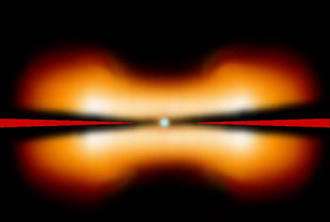AMBER looks into the cradle of planets

An international team of astronomers investigated a disk of gas and dust surrounding a young star, as well as the stellar winds which emanate from that star. The team found unique, previously unknown characteristics of the innermost environment around the star. Another research group carried out the first-ever analysis of the gas and dust material surrounding a "supergiant" star. All of the observations have now been published in the renowned journal Astronomy & Astrophysics.
Image: An artist’s depiction of the immediate environment of a young star, MWC297 (cross-section). The measurements obtained with ESO’s Very Large Telescope Interferometer and AMBER show that the star is surrounded by a disk of gas and dust, and that a stellar wind blows into space above and below the disk. This region, analysed for the first time ever, has dimensions comparable to the orbit of Mars around the sun. Within that region, new planets may be created from the material of the disk. (Image: AMBER consortium)
In order to investigate the immediate environment of a young star with unprecedented accuracy, an international team of researchers led by Fabien Malbet of the University of Grenoble used two telescopes of the Very Large Telescope Interferometer (VLTI) of the European Southern Observatory (ESO), which is located on the Cerro Paranal mountain in Chile. Each of the huge telescope mirrors has a diameter of 8.2 metres; the distance between them is 47 meters. Both telescopes took pictures in the infrared spectral range of the young star MWC 297. Combining these infrared images in the central VLTI beam combination laboratory provides a very high angular resolution. This technique is known as infrared interferometry. The new interferometric instrument AMBER at the VLTI allowed both, the interferometric combination of images from both telescopes and the spectroscopic decomposition of the light.
The observation and analysis of the young star MWC 297 is one of the first results of the new AMBER instrument. It showed that MWC 297 is surrounded by a huge disk of dust and gas, known as an accretion disk. The disk emits radiation of many different wavelengths within the infrared range. The star also has an intense stellar wind blowing out at high speed. In the infrared range, the wind only radiates the light of a single hydrogen emission line, the Brackett-gamma line. AMBER made it possible to measure both components of the light separately and thus, for the first time ever, to determine the physical extent of both the accretion disk and the stellar wind. The disk's infrared radiation is produced in a region with a size of 1.75 Astronomical Units. One Astronomical Unit represents the distance from the earth to the sun: 150 million kilometers. The stellar wind's hydrogen light, on the other hand, comes from a considerably larger area of about 2.5 astronomical units.
The scientists used a new modelling method to evaluate the measured data, interpreting their observations of both the accretion disk and the stellar wind. The star emits the stellar wind's ionised gas in almost all spatial directions. Although the gas near the disk moves at an expansion velocity of only 60 kilometers per second, the stellar wind in the direction of the poles blows at up to 600 kilometers per second. With AMBER, scientists can investigate the physical properties of dust and gas in the immediate vicinity of stars with the highest resolution ever. These are the regions where planets form and we can get entirely new information about conditions underlying the process.
The second AMBER research project, led by Armando Domiciano de Souza at the Max Planck Institute for Radio Astronomy in Bonn, involved combining light from three of the four large 8.2 meter telescopes at the VLTI. Instead of a young star, the observed object was a massive, evolved star named CPD-57°2874. This "supergiant star" is about 10,000 times more luminous and about 50 times larger than our sun. At a distance of 8,000 light years, it is some 10 times further from the Earth than MWC 297. AMBER's detailed observations of this star have contributed to a better understanding of the physical properties of the material in its environment.
The AMBER interferometric instrument was built for ESO by an international consortium which includes the following institutions: Laboratoire Universitaire d'Astrophysique de Nice, Laboratoire d'Astrophysique de l'Observatoire de Grenoble, Laboratoire Gemini de l'Observatoire de la Cote d'Azur, Max Planck Institute for Radio Astronomy in Bonn, and Osservatorio Astrofisico di Arcetri in Florence. The Principal Investigator of the project is Romain Petrov at the University of Nice.
The development of the infrared camera and the data recording software was led by Professor Gerd Weigelt, Director of the Max Planck Institute for Radio Astronomy in Bonn.
Source: Max-Planck-Gesellschaft















